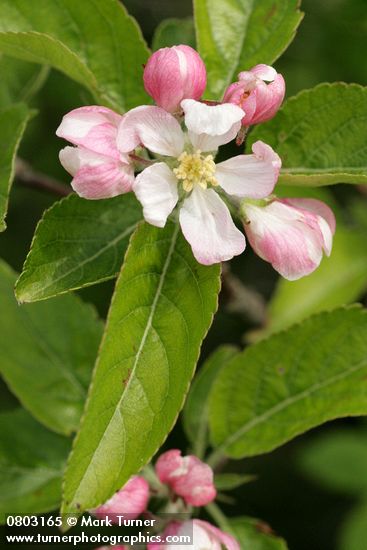Native or Escaped?
I’ve been working up a list of plants that I didn’t find in bloom for Wildflowers of the Pacific Northwest, or that we didn’t plan to include for one reason or another. One of those plants is a small shrubby tree, Pacific crabapple. Phyllis and I left it out of the book because we mostly excluded trees. I’d never made an effort to find it until this year. I asked my native plant colleagues for help finding where it grows and several people pointed me to locations. I found plants a week or so ago, but not in bloom.
 I also found lots of escaped cultivated apple trees blooming in the woods and near wet areas where the native crabapple grows. While some of the escaped apple trees are quite big, it’s easy to confuse them with the native. The flowers look a lot alike, especially when you find an apple with white instead of pink blossoms. You have to look close to see the difference: 3 pistals in the native crabapple and 5 pistals in the domestic apple blossoms.
I also found lots of escaped cultivated apple trees blooming in the woods and near wet areas where the native crabapple grows. While some of the escaped apple trees are quite big, it’s easy to confuse them with the native. The flowers look a lot alike, especially when you find an apple with white instead of pink blossoms. You have to look close to see the difference: 3 pistals in the native crabapple and 5 pistals in the domestic apple blossoms.
This is a blossom of the Pacific crabapple, Malus fusca, which has 5 white petals, about 20 stamens, and 3 pistals. Sometimes the leaves on the crabapple have a small lobe on one or both sides, but not always.
I found this specimen just starting to bloom in the Connelly Creek Nature Area on Bellingham’s south side. More photos are on Pacific Northwest Wildflowers under May 14, 2008.

This blossom is on an escaped cultivated apple, Malus pumila, which has 5 pinkish petals, about 20 stamens, and 5 pistals. It’s difficult to count pistals in a photo, even when viewed at higher resolution than is possible on the web. It can be challenging even in the field. Very good close-up eyesight or a hand lens is essential. I found it helpful to pull the stamens off a blossom so I could clearly see the pistals.
You can see more photos of the cultivated apples that initially fooled me, as well as some other plants in bloom around Bellingham on May 6 at Pacific Northwest Wildflowers.
Sometimes distinguishing what’s native and what’s not is even more difficult. For example, Prunella vulgaris or self-heal, is both native and introduced and it’s the same species, not even differentiated by subspecies or variety. The differences are subtle and for the most part when it’s the same species I don’t get too carried away trying to tell them apart.


Glad to have you back blogging. I am always learning something from your posts. Happy Spring!
Thanks, Cathi. I greatly admire those who are able to write something on a daily basis. I started with great intentions and got distracted by life and other aspects of business along the way.